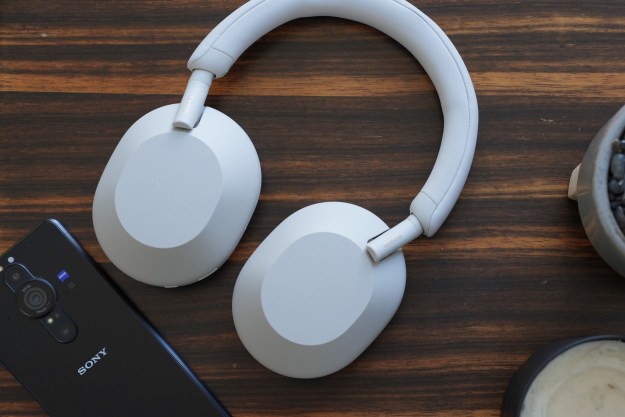
“Bose’s Frames are a brilliant first step in a burgeoning new genre.”
- Excellent lenses
- Sleek design blends in well
- Impressive audio clarity and detail
- Brilliant for biking and outdoor use
- Basic IPX2 water resistance
- Short battery life
- Very weak bass response
- AR applications are limited, iOS only
It takes a lot to make a splash in the audio world these days.
That’s what makes Bose’s Frames — headphones/sunglasses you might actually want to wear — so special. Pegged as conveyors of aural AR and crafted for “sun and sound,” the Frames are a fascinating audio entry from Bose, made all the more intriguing when word began circulating that they actually sound good. Design limitations certainly pigeon-hole them to a degree, as does their $200 price tag. And yet, while the Frames are just an early offering that may (or may not) help kick-start a new genre, they’re also kind of magical.
Christmas in June
Full disclosure: I have an ongoing love affair with both headphones and sunglasses based around what they bring into and block out of my head respectively. So it’s no surprise that unwrapping the Frames inspired some kid-on-Christmas nostalgia.
- 3. Bose Frames Alto
The Frames’ slim, rectangular box gives way to an over-sized sunglasses case layered in beaded vinyl with a Bose logo on the front. Pulling the glasses from the case reveals translucent, matte-plastic frames (Bose really missed the boat not going with “Shades”) decked out in flourishes of gold-colored metal. Swollen earpieces with slim vents along the bottom and sides betray the gadgetry harbored within, but offer enough camouflage to blend in when worn.
The Alto model I chose borrows heavily from Ray-Ban’s classic Wayfarers; the framing around the lenses is larger and more rounded and the overall package isn’t as stylish as the real thing, but they look pretty good for design from an audio brand. More important, they pass muster as regular shades out in the world. The even more stylized and rounded Rondo (hence the name) are not for me. For those shopping fit, though, the Rondo are the smaller version.
A match made in design heaven
The world has no shortage of awkward headgear spawned from utility-inspired collaborations: The beer helmet, the propeller hat (OK, there’s no real utility there), windshield-wiper sunglasses, umbrella hats, Google Glass, the Urban Sombrero — you get the idea. Frankly, at first blush headphone sunglasses would seem to fit into that tragic fashion mold.
My ears basked in lovely tunes, even as the wind whipped by.
But that’s where Bose’s penchant for brilliant sound design comes into play. This is the company that patented noise cancellation, after all, and creating functioning headphones in a pair of sunglasses you feel good about wearing is its own impressive feat.
The earpieces shoehorn all the wireless headphone tech inside (battery, Bluetooth antenna, etc.), while vents at the bottom aim patented drivers directly at your ear canals, with no need for earpads, eartips, or any physical contact. It’s a design you simply wouldn’t expect to work properly — but it does.

Set inconspicuously at the front of the right earpiece is a tiny gold bead that acts as the multi-function button for power, play/pause, song skip, calling, and AI assistant via a series of taps and holds. It’s easy and instantly intuitive. The only real omission here is volume, which is a key miss and one we’re hoping Bose will add via touch controls in the next iteration.
A single LED tucked into the earpiece interior shows charge status, while charging is accomplished via a gold magnetic plate and proprietary USB cable. My first charge attempt must have been misaligned, however, resulting in dead Frames, so you’ll need to take care. They’ll power down automatically in five minutes, or you can simply set them on their top. It’s more elegant than a power switch, but a touch less functional, too.
The black-tinted lenses are of high-quality and work well to fight glare, designed to block 99 percent of UVA/UVB rays (which I assume is good), though they aren’t polarized.
Bose Connect
The Bose Connect app for iOS or Android allows for quick and easy setup, walking you through pairing and control in a matter of seconds. The app also offers other basic functions, including firmware upgrades and download links to Bose’s nascent AR apps, designed to offer a swell of new use cases for your Frames — but only for iPhones and iPads at present.
In your head
After connecting the Frames, announced by a lady robot, and pressing play on my Spotify test playlist to unleash Radiohead’s Burn the Witch, I was completely taken aback by how good it sounded. Then the song’s bass drop kicked in — or rather, didn’t. The lack of punch in the low-end, sounding as though as high as 300Hz or more has been rolled off, was a bit of a shocker at first, re-sculpting the mix in an almost comical fashion.
You can’t really use them inside unless you’re a wannabe rock star.
Once my ears adjusted to the lack of punch, however, I was enthralled by just how musical and clear the Frames’ sound is. Maybe most impressive is the way the stereo image seems to almost materialize inside your head, as if magically beamed within the boundaries of your skull. Strings and guitar are sweetly rendered, horns crunch with breathy definition, and vocals are clean and clear at the center, even as the sounds of the outside world move through your ears with breezy nonchalance.
Allowing for such detail and spritely definition makes the Frames not just functional, but friendly when you put them on, almost daring you to take them along on your outdoor adventures — especially when the sun is shining brightly above.
Call quality
Call quality is generally the same as you’d expect from any good pair of
Limitations …
Right after I’d connected the Frames and began listening, I shared my first impressions with a deskmate whose instant reaction was less optimistic: “Those are cool, but the applications seem pretty limited,” he replied.

He wasn’t exactly wrong. For one obvious point, you can’t really use the Frames inside, especially at the office, unless you don’t mind looking like a wannabe rock star/ass while squinting at your monitor. This leaves out the gym for similar reasons. Even for gloomy days (of which Portland offers plenty), the Frames are limited. You can swap in prescription lenses, but only from third-party vendors, and that obviously adds more to the $200 bottom line.
The Frames also offer just 3.5 hours (or less) of playback time per charge and, unfortunately, they can’t charge in their case to supplement that limitation like so many fully wireless earphones. We appreciate that they’re IPX2 certified for basic water resistance, but that means they’re only splash proof and can’t withstand a serious douse. And because of the open design, extra-loud spaces are also pretty much a no go.
As for AR applications, I admit I didn’t spend a ton of time with them, namely because my primary phone runs Android (hint). Even exploring with my old iPhone, the applications are limited, offering augmented story simulations for workouts (which also work with headphones), ambient soundscapes, and a few other basics. Apart from GPS, the only really practical one for me is the golf guide, and I’m still not sure I want a robot in my head on the course.
… and possibilities
That said, in practice, I found myself much more focused on what the Frames can do than what they can’t.
My first real Frames adventure came in the form of a blissful afternoon bike ride to the hardware store on a golden spring day. My ears basked in lovely tunes, even as the wind whipped by, raising the moment from sweet to sparkling, including a significant moment of reflection at a stoplight listening to Father John Misty’s rendition of Gillian Welch’s Everything is Free.
The stereo image seems to almost materialize inside your head.
A sun-drenched morning walk for a smoothie with my wife similarly transformed from lovely to inspired as I added just a splash of Vampire Weekend’s latest record, while still carrying on a cordial conversation. Had I not told my wife I was testing the Frames she’d have been none the wiser.
That inspired more potential use cases for the Frames: A musical trek in Oregon’s emerald Gorge (without bothering my fellow hikers), pulling weeds on a Sunday afternoon, or just relaxing in the backyard with an icy drink. The Frames offer plenty of enticing ways to splash some music or podcasts into your life, without ever losing touch with the world around you.
Our Take
While limited in use cases (and battery life), Bose’s Frames represent a brilliant first step in a burgeoning new headphone genre, the applications of which are only beginning to be explored.
Is there a better alternative?
With such a distinctive product, this is difficult to answer. If you’re looking for something more traditional and versatile to power your workouts, we suggest checking out the Jabra Elite Active 65t fully wireless earbuds (though be warned that their hear-through DSP technology doesn’t work very well for bike rides). There are also plenty of other great fully wireless earbuds available these days.
You can also check out some similarly angled products from companies like Trekz, such as the Trekz Titanium headphones, and the new Aftershokz Aeropex, both of which use bone conduction to send sound to your ear canal through a bone in your jaw, while keeping your ears unfettered to let in the world around you. We like the versatility of these products, and they generally offer much better battery life, though in my experience bone conduction doesn’t offer sound as vibrant as Bose’s Frames.
How long will it last?
Though delicately designed, the Frames should hold up well over time as long as you keep them in their case and don’t drop them on hard pavement. That said, their meager battery life will only get worse as time goes on.
Should you buy it?
If you’re looking for a unique and exciting new way to get your tunes, and you love to get out in the sun, Bose’s Frames are definitely worth considering. But if you want something more versatile for your $200, you may instead want to try a good pair of fully wireless earbuds.
Editors' Recommendations
- New $129 Moto Buds+ tap Bose for boom and Dolby for head tracking
- Samsung Music Frame hands-on: invisible audio done right
- The best wireless headphones for 2024 from Bose, Sony, 1More and more
- Best Bose 700 deals: Save $151 on the wireless headphones today
- Best Apple AirPods alternatives for 2024: Bose, Sony, Marshall, and more






